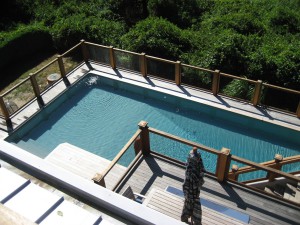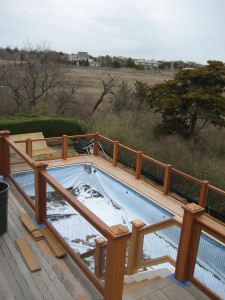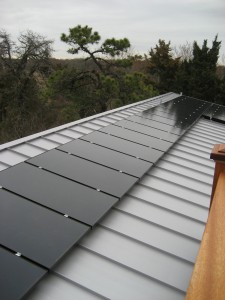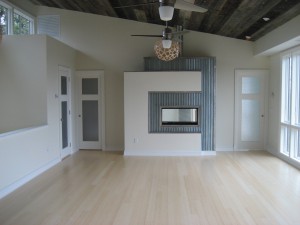 Just weeks after the entire house was demolished during the first stages of the Kearn’s renovation, I received a call asking if I would consider taking over their project. The former architect, owner and contractor could not see eye to eye and the project was put on hold. Knowing how the right chemistry is very important I agreed to meet the contractor and visit the site to see for myself what was the current state of construction. The meeting went quite well, and many of the issues that the contractor had, were valid construction related issues that I agreed with. I was told by the owner, that their previous architect was a fancy architect from Tribeca, that did condo and coop renovations, but was very limited to large scale construction projects, thus with my background in new construction, I was the architect to best take over this project. After I accepted, the owner asked if there was anyway we could try to make the house as green as possible and try to get the house LEED certified. I had just finished working on a house that was featured on “Renovation Nation” dedicated to green building, so I thought this would be a great new challenge.
Just weeks after the entire house was demolished during the first stages of the Kearn’s renovation, I received a call asking if I would consider taking over their project. The former architect, owner and contractor could not see eye to eye and the project was put on hold. Knowing how the right chemistry is very important I agreed to meet the contractor and visit the site to see for myself what was the current state of construction. The meeting went quite well, and many of the issues that the contractor had, were valid construction related issues that I agreed with. I was told by the owner, that their previous architect was a fancy architect from Tribeca, that did condo and coop renovations, but was very limited to large scale construction projects, thus with my background in new construction, I was the architect to best take over this project. After I accepted, the owner asked if there was anyway we could try to make the house as green as possible and try to get the house LEED certified. I had just finished working on a house that was featured on “Renovation Nation” dedicated to green building, so I thought this would be a great new challenge.
Existing conditions had to be documented, and new drawing needed to be drawn. It was also late fall, so direction had to be given to the contractor to close up the house before the weather really damaged anything that was being saved in the inside. The drawings were redone, and I worked with the clients and contractor to select materials that would be green, and that the contractor could get to the site and install. I also worked with Steven Winter and Associates, the premier LEED certification agency. All documentation needed to go through an agency for submittal. There were so many forms and testings along with documentation of each phase, before walls were closed. We made weekly site visits, meeting with the contractor and documenting the process.
Through construction, some of the testing that was done was the blow test, to ensure that the seals around windows and doors. were secure. Another test was the infrared heat test that showed any heat loss around windows, walls and doors. This technology was very new when we did these tests.
Along with testing and making sure that there is adequate insulation and energy efficient windows, part of certification includes the materials that are used in the construction. Not only should they have recycled content, but also LEED is concerned with how far they are shipped. We were limited to five hundred miles to ensure LEED points. I spent much time, drawing a radius around our site and verifying where the materials were produced. For the exterior of the house and some of the interior, we found an old barn that was being torn down in Pennsylvania, and used that siding for the exterior of the house and the ceiling in the living/kitchen. We also used all compact fluorescent lightbulbs or lcd light bulbs. In addition to the materials, we were able to install forty-two solar panels on the roof as it is south facing with reflections off the water.
Attached is the documentation of the LEED Certification. We were able to work with the owners and Steven Winters to receive a Silver rating.








